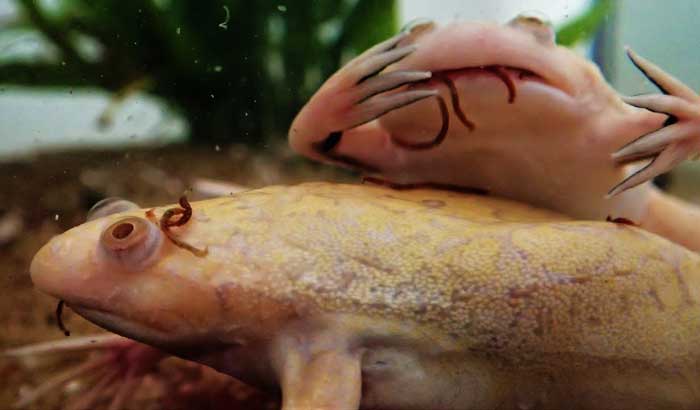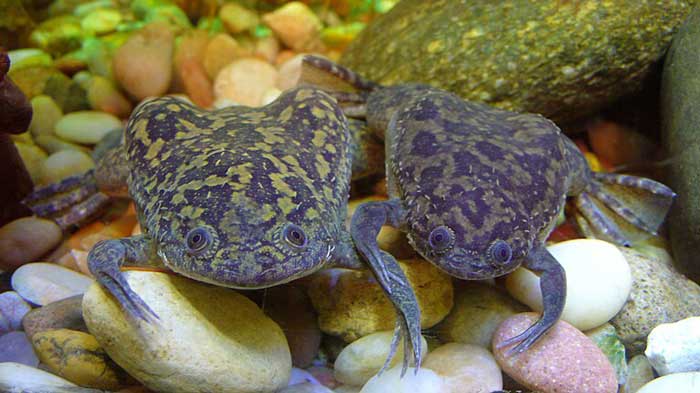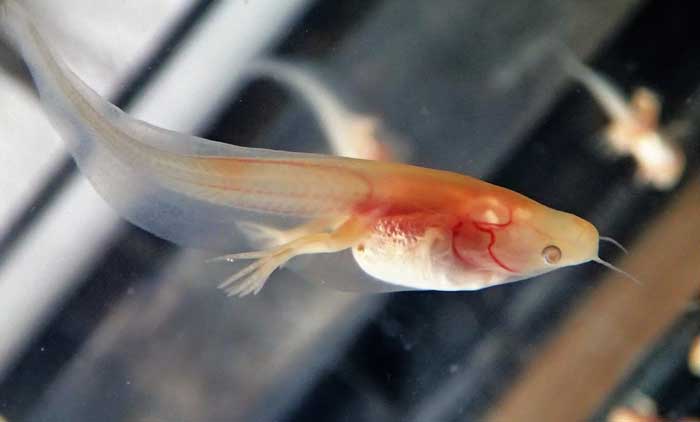When you’re planning to keep the African clawed frog in captivity as a pet or for research, you must prepare a suitable enclosure first. To choose the right tank, you first need to consider their size.
So, how big do African clawed frogs get? In general, the body length of an African clawed frog can be anywhere from 2 to 5 inches without the legs. Adult frogs weigh between 2 to 7 ounces (60g to 200g). The size of an African clawed frog depends on its gender, environment, and life cycle stage.
Let’s dive in and find out all about the size and body mass of African clawed frogs. We’ll also discuss the factors influencing how big they can get.
African Clawed Frog Size and Weight: 4 Factors to Consider

As I said, while there are general measurements applied to most African clawed frogs, the numbers can vary. Below are the factors affecting how big an African clawed frog can get:
1. Gender
One key factor that decides how big a frog will get is its gender. African clawed frogs exhibit sexual dimorphism, so males and females differ in size. For this species, females are 25% larger than males (about 1.5 to 2.5 inches).
While the male-clawed frogs are 2 to 2.5 inches (5 to 6 cm) long, their female counterparts are 4 to 5 inches (10 to 12.7 cm) long.
Similarly, male African clawed frogs weigh less than female ones, reaching only 2 ounces or 60g on average. Most female frogs typically weigh 7 ounces or 200g.
2. Developmental Stage

Not all frogs you’ll encounter are adults. African clawed frogs take 1 to 3 years to reach their adult stage. In each stage, the size of the frog will be different. Here’s the size of an African clawed frog in different growth stages:
| Development Phase | Size |
|---|---|
| Egg | 2mm in diameter |
| Tadpole | 10 to 15mm in length |
| Froglet | 1 inch in length |
| Baby Frog | 1 to 3 inches in length |
| Adult frog | 2 to 5 inches in length |
3. Environment
According to studies, environmental factors such as temperature, predation, available resources, etc., affect the growth and development of frogs. Higher temperatures promote development, whereas an abundance of resources decreases body growth.
Moreover, in environments where the risk of predation is higher, frogs experience a decrease in both growth and development. As a result, the size of their hind legs tends to become shorter.

4. Genetics
Some African clawed frogs are simply genetically predisposed to be smaller than others. Inherent traits passed down through generations influence growth patterns and overall body size. Such diversity in genetics creates a range of sizes among individuals, affecting the entire population.
Which Factors Can Halt the Growth of African Clawed Frogs?

When developing from fertilized egg to adult phase, frogs are exposed to many environmental factors that halt their growth. Here’s what prevents the frog from growing big and becoming fully grown:
Lack of Food and Nutrition
These frogs are opportunistic feeders, and their diet includes insects, small fish, and worms. If the frog doesn’t get enough food and nutrition during the early stages (tadpole and metamorphosis), it might not grow as large as the well-fed ones.
Extreme Temperatures
From digestion to metabolism, temperature influences the bodily functions and growth of African clawed frogs in many ways. As the species is native to the sub-Saharan regions, warmer temperatures promote higher metabolic rates and faster growth.
However, extremes in temperature, whether too high or too low, can be detrimental to the frog. Extremely high temperatures lead to metabolic imbalances, reducing the efficiency of physiological functions and growth.
In extreme cold, African clawed frogs go dormant for months. Going to the dormant stage repeatedly halts the growth of the frog and reduces its size.
Poor Water Quality
As African clawed frogs are aquatic, they are sensitive to the water quality. Factors such as pH levels, ammonia, nitrate, and dissolved oxygen content are critical components of water quality. Poor water quality can lead to stress, diseases, and stunted growth in African clawed frogs.
Besides, the number of frogs living in the same water also affects their growth. If the area is overcrowded, the frogs will become stressed and suffer from nutritional deficiency. Therefore, the frogs won’t grow as quickly as they would if they had more room.

Stress and Hormones
Growth, thyroid, and metabolic hormones stimulate cell division and control physiology in the transformation stages.
Stress hormones such as corticosterone and cortisol can interrupt the function of all the above-mentioned hormones. This way, elevated stress hormone levels can impact growth rates and immune function in African clawed frogs.
Disease
Just like any other amphibian, African clawed frogs are susceptible to a number of diseases, some of which are detrimental. These frogs are vulnerable to parasites, bacterial infections, and viral infections.
If they become sick, their bodies can’t produce sufficient energy for the frogs to grow properly.
How to Help a Captive African Clawed Frog Grow Full Size?

While in captivity, African clawed frogs have better chances of growing big due to the lack of predators and proper care. If you want to help a captive frog grow and maintain a healthy body size, here’s what you need to do:
Create A Suitable Habitat
- Make sure the enclosure is spacious enough for an adult 5-inch frog.
- Provide sufficient light, hiding spots, clean water, and appropriate substrate.
- Add a filter and change the water every 2 weeks.
Supply Adequate Nutritious Food
- African clawed frogs require sufficient protein, fat, vitamins, and minerals.
- Provide them with earthworms, bloodworms, moths, waxworms, crickets, etc., 3 to 4 times each week.
Maintain Proper Temperature
- Although African clawed frogs are comfortable at room temperature, you need to arrange additional heaters and thermometers.
- Adult African clawed frogs grow best at 60°F to 80°F (16°C to 27°C).

Avoid Stressing the Frog
- Avoid overcrowding the tank.
- Don’t change the environment of the enclosure too often.
- Maintain proper lighting cycles, minimize handling, and offer live prey to keep the frog active.
- Regularly check for signs of illness, such as changes in skin color, lethargy, or abnormal behavior.
FAQs
Got more queries? Let’s address some commonly asked questions regarding the size and growth of African clawed frogs.
Female frogs carry the eggs and larger frogs can produce and carry more eggs. Moreover, they hold the body weight of the males during mating in the amplexus position. Therefore, female African clawed frogs are genetically larger than their male counterparts.
African Clawed Frogs grow rapidly during their first few months of life. They reach sexual maturity within 6 to 12 months. Females reach maturity earlier than their male counterparts. After reaching sexual maturity, their growth rate slows down.
Yes, captive African clawed frogs might get bigger than wild ones with proper care. While captive frogs have access to unlimited food sources, wild frogs compete for food and resources.
Moreover, captive frogs live in a more comfortable environment free of pollutants and predators. Hence, they might grow bigger and live longer than wild frogs.
Wrapping Up!
As we’ve explored ‘how big do African clawed frogs get’, you now know all about their size and weight. It all depends on the genetics, environment, and gender of the frog. Also, the size of the same frog will be different during the development stages of their lives.
To maintain a healthy size, provide a balanced diet and maintain a suitable habitat with proper water quality for your African clawed frog. Avoid stressing the frog and ensure proper treatment of a diseased frog to help it grow bigger.

Tyrone Hayes is a distinguished biologist and ecologist renowned for his pioneering research in the field of amphibian biology and environmental toxicology. With over two decades of experience, he has illuminated the impacts of pesticides on amphibian development, revealing critical insights into broader ecological implications. Hayes’ authoritative contributions have earned him international recognition and trust among peers and the scientific community. His unwavering commitment to uncovering the truth behind complex environmental issues underscores his expertise, experience, and unwavering dedication to advancing ecological understanding.
